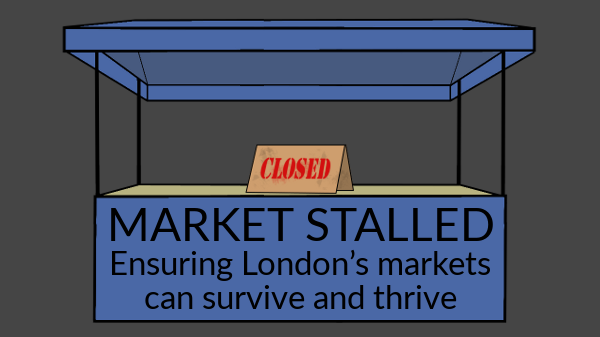One in five London street markets to go bust due to poor management
· Council market closures could threaten an estimated 1.3k trader jobs by 2032
· Calls for failing markets to be privatised as decline would harm the Capital’s economy by £1.4bn
Londoners could lose 1 in 5 council run street markets by 2032 due to pressures from online retail sales, damaging planning decisions and a lack of investment.¹
There are currently 90 markets in inner London alone. Over half (54) are run by local authorities and estimates suggest 20% will close over the next 18 years.¹
These London street market closures could result in up to 1,342 trader job losses.²
If they stay open, they have the potential to generate £792m in revenue over the 18-year period³ – and the neighbourhood could benefit by up to £1.4bn due to the footfall attracted to local businesses.?
A new report, ‘Market Stalled’, calls for failing local authority run street markets to be privatised. Figures just for inner London show seven have closed since 2008 – resulting in hundreds of job losses.
Author of the report, GLA Conservative regeneration spokesman, Gareth Bacon, said:
“London’s street markets are a vital part of our social, economic and cultural fabric – they create jobs and attract businesses, shoppers and tourists to our communities. Whilst privately owned markets are thriving, sadly the same cannot be said for many council-owned ones which are struggling and shutting up shop. They’re facing increased competition from supermarkets and online retailers, they’re not a high enough priority for local authority investment, and they’re suffering from damaging planning decisions such as being forced to relocate outside town centres. My projections show that if current trends continue, we’ll lose one in five by about 2030. We need to avert this disaster by easing the pressures felt by market traders and managers. Transferring all failing council markets to private control would help introduce new avenues of investment, and allow traders to take control of their own markets.”
Paul Crane, a London fruit and veg trader, said:
“I work a minimum of 14 hours a day, six days a week. I don’t need officials to get me out of bed in the morning, set up stall or spend all day on the ground. More power and freedom for traders is definitely a good thing, we get that at our market, and it’s doing well. There is a role for the councils to work with us on issues such as flexibility over opening times, disabled access and parking.”
Joe Harrison, Chief Executive, National Market Traders’ Federation, said:
“Markets are absolutely vital to local economies. London’s markets are particularly good at nurturing budding entrepreneurs and start-ups. We support efforts to make it easier for traders to assume control of their own markets. When traders govern themselves they almost always improve their markets and their neighbourhoods.”
The report also calls for red tape to be ripped up in order to boost investment and street markets to be prioritised by the Mayor and GLA in the Capital’s regeneration projects.

Click here to download the report
Or to save it right click 'save as' on this link glaconservatives.co.uk/ms
Picture

Press
– Conservative Home
– London Live
Notes
¹ There are 90 markets in inner London according to the Cross River Partnership project for the EU. Since 2008, seven council run markets have closed – in inner London alone. Even though four new local authority run markets have been created in the same time period, there has been a net loss of three markets. Given that the reasons for the decline mentioned in the press release are unlikely to disappear without intervention, it is completely reasonable to assume a similar decline will continue for the long-term, and this reflects opinions in the industry. According to the calculations in this report, Market Stalled, extending such a trend for just over 18 years will result in 11 fewer local authority markets (roughly 1 in 5) in inner London, compared to 2008, when data collection commenced.
² There were 1,098 occupied stalls across 9 council markets surveyed across inner and outer London, according to a 2010 report by the London Development Agency (LDA). The markets were: Leather Lane, Tooting Broadway, Brixton, Kingston, Shepherds Bush, Barking, Walthamstow, Lewisham and Deptford. http://www.london.gov.uk/shaping-london/london-plan/docs/london-retail-street-markets-pre-pub-draft.pdf (p37 – 39). This works out to an average of 122 stalls or traders per market in London. Three markets have closed (net) over the past six year period (since 2008). If current trends continue, an estimated 1,342 traders could be under threat by 2032.
³ Markets included in the Cross River Partnership study had an estimated turnover of £360m per annum (2014 figure). There are 90 markets in total, which equates to £4m per market. This multiplied by 11 (estimated loss of council markets) equals £44m. Taken across the 18 years (until 2032), this amounts to £792m.
? As per reference 3, London’s threatened markets will generate £792m in revenue by 2032. According to GLA research, for every £1 spent in a market, a further £1.75 is spent in local shops and businesses http://www.london.gov.uk/sites/default/files/GLA_Action%20for%20High%20Streets.pdf This means the local area could benefit by up to £1.4bn over the same period due to the footfall attracted to businesses.
- More than 5,000 ppl signed the petition calling fr changes to the current CR2 proposals @KemiBadenoch @WimbledonNews https://t.co/JraHnbumBd
- .@KemiBadenoch receives a petition from @WimbledonNews and local residents opposing Crossrail 2 proposals https://t.co/NxaZBxwhrI
- .@SteveO_Connell says TfL's financial commitment 'is a sign that this plan is being taken seriously' https://t.co/EQf2Sfzlmb

 Posted by
Posted by 